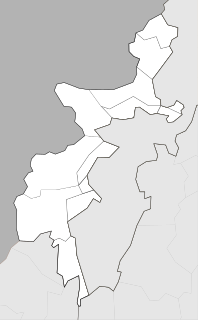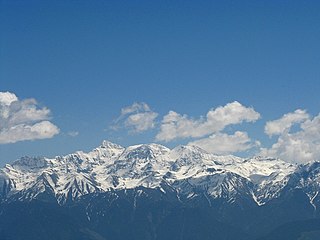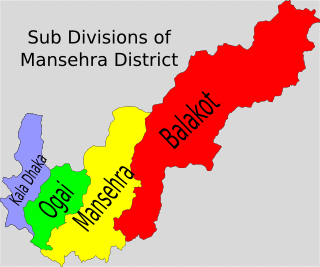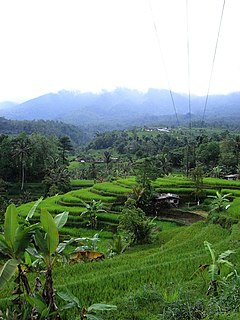
The Hindu Kush, also known in Ancient Greek as the Caucasus Indicus or Paropamisadae, is an 800-kilometre-long (500 mi) mountain range that stretches near the Afghan-Pakistan border, from central Afghanistan to northern Pakistan. It forms the western section of the Hindu Kush Himalayan Region (HKH). It divides the valley of the Amu Darya to the north from the Indus River valley to the south.

The Sulaiman Mountains, or Kōh-e Sulaymān, are the southern extension of the Hindu Kush mountain system, located in the Zabul, Kandahar and Loya Paktia regions of Afghanistan, and in northern Balochistan and some parts of southwestern Khyber Pakhtunkhwa and Punjab in Pakistan. The Sulaimans form the eastern edge of the Iranian Plateau where the Indus River separates it from the Indian Subcontinent. Bordering the Sulaimans to the north are the arid highlands of Central Hindu Kush or Paropamisadae, whose heights extend up to 3,383 metres (11,099 ft).

The Afrīdī is a Pashtun tribe present in Pakistan, with substantial numbers in Afghanistan. The Afridis are most dominant in Pakistan's Federally Administered Tribal Areas, inhabiting about 100p mi² (8000 km²) of rough hilly area in the Zarlash eastern Spin Ghar range west of Peshawar, covering most of Khyber Agency, FR Peshawar and FR Kohat. Their territory includes the Khyber Pass and Maidan in Tirah. Afridi migrants are also found in India, mostly in the states of Uttar Pradesh, Bihar and Jammu and Kashmir.
The Jadoon, also called Jadun or Gadun , are a Pashtun tribe. Jadoon's originated in the mountainous regions of Spin Ghar, in the Nangahar Province of Afghanistan.

Jamrūd or Jam is a town in the Khyber District of Khyber Pakhtunkhwa, Pakistan. Located in the Valley of Peshawar, on the western fringe of Peshawar city, Jamrud is the doorway to the Khyber Pass which is just to the west of the town. The pass connects Jamrud with Landi Kotal to the west, located near the border of Afghanistan's Nangarhar Province.

The Tirah Campaign, often referred to in contemporary British accounts as the Tirah Expedition, was an Indian frontier war during 1897–98. Tirah is a mountainous tract of country in what is now a federally administered tribal area of Pakistan.

Spīn Ghar, "white mountain", also known as Safēd Kōh, Speen Ghar, or the Indian Caucasus as late as the 19th century, and as the Morga Range, is a mountain range in eastern Afghanistan, which expands into Khyber Pakhtunkhwa, Pakistan. It is situated in the East of 'Dra Khebar'. Its highest peak, straight and rigid Mount Sikaram, towers above all surrounding hills to 4,761 m (15,620 ft) above mean sea level. The Kabul River cuts a narrow trough through the Spīn Ghar mountains to flow eastward into the Indus River; otherwise, the range connects directly with the Shandur Top offshoot of the Hindu Kush mountain system.

The Pir Panjal Range is a group of mountains in the Inner Himalayan region, running from east-southeast (ESE) to west-northwest (WNW) across the Indian states of Himachal Pradesh and Jammu and Kashmir where the average elevation varies from 1,400 m (4,600 ft) to 4,100 m (13,500 ft). The Himalayas show a gradual elevation towards the Dhauldhar and Pir Panjal ranges. Pir Panjal is the largest range of the lower Himalayas. Near the bank of the Sutlej river, it dissociates itself from the Himalayas and forms a divide between the rivers Beas and Ravi on one side and the Chenab on the other. The renowned Galyat mountains are also located in this range.
The Samana Range is a mountain ridge in the Hangu District of the Khyber Pakhtunkhwa of Pakistan, commanding the southern boundary of Tirah. The ridge lies between the Khanki Valley on the north and the Miranzai Valley on the south, and extends for some 30 m. west from Hangu to the Samana Suk. It is some 6000 to 7000 ft. high.

Torghar District, Hindko: کالا ڈهاکه, English Black Mountain formerly also known as Kala Dhaka is the smallest district in Pakistan of Hazara Division in Khyber Pakhtunkhwa province. It was officially separated from Mansehra District in 2011 under Article 246 of the Constitution of the Islamic Republic of Pakistan. According to the 1998 census, the Mansehra subdivision then known as Kala Dhaka had a population of 174,700, of which 96% had Pashto as their first language.

Khyber District is a district in Peshawar Division of Khyber Pakhtunkhwa province in Pakistan. Until 2018, it was an agency of Federally Administered Tribal Areas, with merger of FATA with Khyber Pakhtunkhwa, it became a district. It ranges from the Tirah valley down to Peshawar. It borders Nangarhar Province to the west, Orakzai District to the south, Kurram District to south west, Peshawar to the east and Mohmand District in north.

Mount Sikaram is a mountain on the Afghanistan–Pakistan border, south of the Kabul River and Khyber Pass. At 4,755 m (15,600 ft), it is the highest peak of the Spīn Ghar, or Safēd Kōh, mountain range.

The Khyber Rifles is a para-military force forming part of the modern Pakistani paramilitary's Frontier Corps. Dating from the late nineteenth century the regiment provided the title and setting for a widely read novel, King of the Khyber Rifles.

The Khyber Pass is a mountain pass in the northwest of Pakistan, on the border with Afghanistan. It connects the town of Landi Kotal to the Valley of Peshawar at Jamrud by traversing part of the Spin Ghar mountains. An integral part of the ancient Silk Road, it has long had substantial cultural, economic, and geopolitical significance for Eurasian trade. Throughout history, it has been an important trade route between Central Asia and South Asia and a vital strategic military choke point for various states that came to control it. The summit of the pass is 5 km (3.1 mi) inside Pakistan at Landi Kotal, while the lowest point is at Jamrud in the Valley of Peshawar. The Khyber Pass is part of Asian Highway 1 (AH1).
Kala Khel is a clan of Tirah Adam Khel. Adam Khel is a sub-tribe of Afridi that has originated from the Karlanee or Karlani group of Pashtuns. The Kala Khel clan of Tirah Adam Khel inhabits in FR Peshawar region and in Bara and Torghar as well. It can be found on Google Maps at 33.728623N,71.55256E and Tirah valley of Khyber agency at 33.73N, 71.01E.
Khyber was the code-name for a military offensive conducted by Pakistan's military in the Khyber Agency in four phases; Khyber-1, Khyber-2, Khyber-3 and Khyber-4.
This was a military campaign conducted by British and Indian armies against Afridi tribesmen in the North West Frontier region of the Indian Empire, now in Pakistan.















